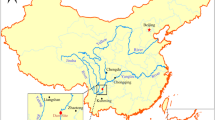Abstract
To study the influence of the variation of reservoir water level and rainfall on the seepage characteristics and stability of the core dam, considering the coupling effect of seepage field and stress field, finite element simulation of seepage and stability of dam slope when the core dam encounters the variation of reservoir water level and rainfall was carried out based on the unsaturated seepage principle, different rainfall intensities, different rainfall types and different variation rates of reservoir water level were selected for finite element simulation. The results show that: The variation rate of water level mainly affects the time when pore water pressure tends to be stable. The rainfall intensity and rainfall type mainly affect the pore water pressure in the upper part of the dam, and the higher the rainfall intensity, the more drastically the pore water pressure changes in the upper area of the core dam. Rainfall type and rainfall intensity are the main factors that affect the safety factor of the downstream slope of the core wall dam, but have little effect on the safety factor of the upstream slope. When the safety factor of the downstream dam slope tends to be stable, the order of the safety factor of different rainfall type is: forward type > = center type > average type > post-peak type. Whether the water level rises or falls, rainfall will reduce the safety factor of downstream dam slope. The results of this study provide a reference for correctly understanding the seepage and stability law of the slope of core dam and a reference for risk analysis and emergency management when the core dam encounters extreme working conditions.


















Similar content being viewed by others
References
Ayanlade A, Radeny M, Morton JF et al (2018) Rainfall variability and drought characteristics in two agro-climatic zones: an assessment of climate change challenges in Africa. Sci Total Environ 630:728–737
Capparelli G, Damiano E, Greco R et al (2019) Physical modeling investigation of rainfall infiltration in steep layered volcanoclastic slopes. J Hydrol 580:124199
Cen WJ, Li DJ, He HN (2016) Analysis of dike seepage and slope stability under coupled conditions of continuously heavy rainfall and consequent change of water level. J Hohai University 44(4):364–369
Chen SS, Zhong QM, Cao W (2012) Breach mechanism and numerical simulation for seepage failure of earth-rock dams. Sci China Tech Sci 42(6):697–703
Cui J (2017) Study on impact from various reservoir water level fluctuation rates on dam slope stability. Water Conserv Hydropower Technol 48(2):155–159
Elkamhawy E, Wang H, Zhou B et al (2018) Failure mechanism of a slope with a thin soft band triggered by intensive rainfall. Environ Earth Sci 77(9):340
Dou HQ, Han TC, Gong XN et al (2014) Probabilistic slope stability analysis considering the variability of hydraulic conductivity under rainfall infiltration–redistribution conditions. Eng Geol 183:1–13
Hamdhan IN, Schweiger HF (2013) Finite element method-based analysis of an unsaturated soil slope subjected to rainfall infiltration. Int J Geomech 13(5):653–658
Huang H, Song DS, Yun HS et al (2011) Water level change caused from three gorges dam construction in Yangtze river basin. J Coastal Res, pp 1672–1675.
Jeong S, Kim Y, Park H et al (2018) Effects of rainfall infiltration and hysteresis on the settlement of shallow foundations in unsaturated soil. Environ Earth Sci 77(13):494.1–494.12.
Jinxin L, Deng J, Yuanfang C et al (2019) Variation of the water level in the Yangtze river in response to natural and anthropogenic changes. Water 11(12):2594
Junghwan Kim, Yongmin Kim, Sangseom et al (2017) Rainfall-induced landslides by deficit field matric suction in unsaturated soil slopes. Environ Earth Sci
Li AR, Deng H, Xiao YY et al (2019) Stability analysis of a deposit slope under rainfall conditions. Pearl River 40(11):56–61
Lin HZ, Li GX, Yu YZ et al (2007) Influence of matric suction on shear strength behavior of unsaturated soils. Rock Soil Mech 28(9):1931–1936
Ni SS, Zhang XF (2016) Influence of ascending and descending water level on seepage field and stability of Naban core earth-rock dam. Water Resources Power 34(3):84–87
Tu XB, Kwong AKL, Dai FC et al (2009) Field monitoring of rainfall infiltration in a loess slope and analysis of failure mechanism of rainfall-induced landslides. Eng Geol 105(1–2):134–150
Wang KT, Xie LY, Liu H (2018) Study on seepage field and slope stability of homogeneous earth-rock dam under action of drawdown of reservoir water level. Water Resources Power 36(8):81–84
Xiang G, Wang CL, Bai MZ et al (2013) Stability analysis of slope under the condition of rainfall infiltration. Appl Mech Mater, pp 405–408, 256–261.
Yu SY, Zhang JX, Ren XH et al (2018) Influence of different rainfall patterns on seepage and stability of shallow and deep landslides. Water Resources Power 36(3):123–127
Zhang JY, Xiang Y (2018) Analysis on the impact of climate change on the water conservancy project safety. Sci Sinica Technol 48(10):1031–1039
Acknowledgements
The authors gratefully acknowledge the finances support provided by: National Key R&D Program of China [Grant No. 2016YFC0401603]; National Key R&D Program of China [Grant No. 2018YFC0407105]; National Natural Science Foundation of China [Grant No. 51679151]; National Natural Science Foundation of China [Grant No. 51779154]; Special Fund item of Basic Scientific Research Operation Expenses of Central Public Welfare Scientific Research Institute [Grant No. Y717012].
Author information
Authors and Affiliations
Corresponding author
Ethics declarations
Conflicts of interest
The authors wish to confirm that there are no known conflicts of interest associated with this publication.
Additional information
Publisher's Note
Springer Nature remains neutral with regard to jurisdictional claims in published maps and institutional affiliations.
Rights and permissions
About this article
Cite this article
Su, Z., Chen, G. & Meng, Y. Study on Seepage Characteristics and Stability of Core Dam Under the Combined Action of the Variation of Reservoir Water Level and Rainfall. Geotech Geol Eng 39, 193–211 (2021). https://doi.org/10.1007/s10706-020-01486-0
Received:
Accepted:
Published:
Issue Date:
DOI: https://doi.org/10.1007/s10706-020-01486-0




